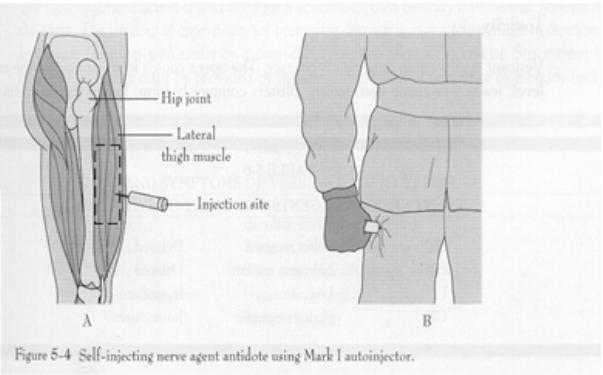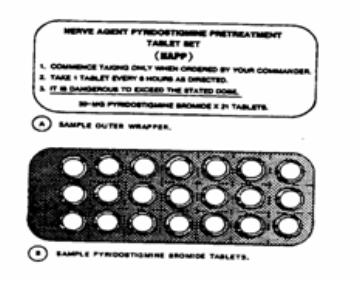UNITED STATES MARINE CORPS
Field Medical Training Battalion
Camp Lejeune
FMST 1412
Manage Chemical Agent Casualties
TERMINAL LEARNING OBJECTIVES
1.
Given a chemical warfare agent casualty in a combat
environment and standard field medical equipment and supplies, manage chemical
agent casualities to prevent further injury or death. (FMST-HSS-1412)
ENABLING LEARNING OBJECTIVES
1.
Without the aid of references, given a description
or title, identify the types of chemical agents, per the student handout.
(FMST-HSS-1412a)
2.
Without the aid of references, given a description
or list, identify the signs and symptoms of various chemical agents, per the
student handout. (FMST-HSS-1412b)
3.
Without the aid of references, given a description
or list, identify the appropriate treatments for chemical agent
casualties, per the student handout. (FMST-HSS-1412c)
 1.
HISTORY OF CHEMICAL WARFARE 1.
HISTORY OF CHEMICAL WARFARE
The use of chemical weapons dates from at least 423
B.C. when allies of Sparta used sulfur fumes during the Peloponnesian War. In
World War I, German units released Chlorine and Mustard Gas which caused several
thousand casualties and deaths at Ypres, Belgium.
During
World War II, Germany utilized cyanide gas and other chemical agents in its
concentration camps. Widely publicized reports of Iraqi use of chemical agents
against Iran during the 1980's led to a United Nations investigation that
confirmed the use of Sulfur
Mustard (HD) and Sarin (GB). During Operation Desert Storm, the United States
destroyed several Iraqi chemical stockpiles both on air and land. Since
Operation Desert Storm,
congress has passed a bill mandating the destruction of all U.S. chemical
agents.
2.
CHEMICAL WARFARE (CW)
Defined as: The use of chemical agents in military operations to kill,
seriously injure or incapacitate personnel through physiological effects. They
can be dispersed by missiles, rockets, bombs, mines, spray tanks or artillery
rounds.
3.
TYPES OF CHEMICAL WARFARE AGENTS
 Nerve
Agents - nerve agents a primarily organophosphores esters similar to those
in insecticides They inhibit the function of cholinesterase (the chemical that
allows a message to travel from one nerve to another). Nerve
Agents - nerve agents a primarily organophosphores esters similar to those
in insecticides They inhibit the function of cholinesterase (the chemical that
allows a message to travel from one nerve to another).
Examples:
GA -
Tabun
GB -
Sarin
GD -
Soman
VX
Descriptions of Nerve Agents:
-
Colorless to light brown liquid
-
Nonpersistent
- Faint
fruity odor
- May be
inhaled, ingested and absorbed through the skin
- Most toxic chemical agents
Signs / Symptoms of Nerve
Agents:
- Can
appear in seconds to hours depending on the agent and amount of exposure
- Massive
secretions (rhinorrhea, lacrimation, incontinence, diaphoresis, etc.)
- Chest
tightness
- Headache
above the eyes with blurred vision
-
Localized muscle twitching (which can progress into convulsions)
-
Constricted pupils
-
Respiratory arrest
- Death
will result if left untreated
Treatment of Nerve Agents:
- Don
protective mask
-
Decontaminate exposed skin
-
Intramuscularly, inject MARK I Kit:
- The MARK
1 Kit includes two autoinjectors, one of 2mg Atropine Sulfate and the other of
600 mg 2 PAM-Chloride. The steps for administering the MARK 1 Kit are as
follows:
a.
Grasp the Atropine autoinjector like a pen. Remove
yellow cap. Press green tip against the meaty portion of the thigh and hold in
place for 10 seconds (See figure 1).
b.
Grasp the 2 PAM-Chloride autoinjector like a pen.
Remove gray cap.
c.
Press black tip against the meaty portion of the
thigh and hold in place for 10 seconds.
d. If signs/symptoms are mild, member can administer
their own kit.
e. One kit may be given every 10 minutes until
improvement is seen or a total of three kits have been given.
f. If signs/symptoms are severe, (member is unable to
inject themselves) give all three kits immediately then inject 10mg Diazepam.
g.
If symptoms continue after three kits have been
administered, medical personnel may administer repeated Atropine (2mg)
injections at three to five minute intervals and should be titrated to a
reduction of secretions and to a reduction of ventilatory resistance (atropinization).

Figure
1. Injecting the MARK 1 Kit
Prevention (Pretreatment) for Nerve
Agents
- Pyridiostigmine is a drug that inhibits nerve agents from
binding to 20-40% of the enzyme acetylcholinesterase. (See figure 2)
- Dosage -30 mg every eight hours not to exceed fourteen days.
Comes in a blister pack with 21 tablets, each 30mg.

Figure 2. Pyridiostigmine Blister Pack
Vesicants (Blister Agents) - the exact mechanism by
which they produces tissue injury is not known
Examples:
HD -
Distilled Mustard

HN
- Nitrogen Mustard
Lewisite
Phosgene Oxide
Descriptions of Blister
Agents:
- Light yellow to brown oily liquid that becomes a vapor at high
temperatures
-
Persistent
-Odor:
- Distilled Mustard (HD) - smells of garlic or horseradish
- Nitrogen Mustard (HN) - smells fishy
- Lewisite (L) - smells like geraniums
- Phosgene Oxide - smells pepperish/ pungent odor
- Heavier
than water
- May be
absorbed through the skin (especially moist areas)
Signs / Symptoms of Blister
agents:
-
Appear any where from 2 - 48 hours after contamination
-
Erythemic skin with blisters, and necrosis where the agent touches
- Nausea
and vomiting
- Edema of
the eyes, eyelids, and corneal scarring
- If
ingested or systemic, intense pain in the GI tract and diarrhea
Treatment for Blister Agents:
- Don
protective mask
-
Decontaminate exposed skin
- Flush
eyes with copious amounts of water to prevent scarring of the Cornea
- Apply
Vasoline to the eyes to prevent adhesions
- Apply
Calamine lotion to reduce burning and itching of skin
- Consider
giving Morphine for pain if needed
- Use
antibiotics and IV fluid replacement as required
Blood Agents - blood agents react with metal complexes
of body to prevent intracellular oxygen utilization.
Examples:
- AC -
Hydrogen Cyanide
- CK -
Cyanogen Chloride
Descriptions of Blood Agents:
-
Colorless liquids dispersed in gas form
- Smells
like bitter almonds or peach pits
- Must be
inhaled
Signs / Symptoms of Blood
Agents:
-
Hyperpnea (Rapid Breathing)
- Anxiety,
agitation, vertigo
- Weakness
- Nausea /
Vomiting
- Cherry
red skin, may be streaked
-
Unconsciousness and seizures within 30 seconds of exposure
-
Respiratory arrest and death within two to four minutes if treatment is delayed
Treatment of Blood Agents:
- Don protective mask
- Decontaminate exposed skin. Move to fresh air
- Vigorously treat symptomatically
- Administer IV Sodium Nitrite (10ml) followed by IV Sodium
Thiosulfate (50ml)
- Second treatment with each of the two antidotes may be given at
up to half the original dose if needed
Choking Agents - Choking agents break down the
alveolar capillary membranes resulting in pulmonary edema.
Examples:
- CG -
Phosgene
- DP -
Diphosgene
- CL -
Chlorine
Descriptions of Choking
Agents:
- Colorless liquid to white cloud which turns into a vapor
- Smells like freshly mown hay, grass or corn
- Must be inhaled
- Contaminated food is of little consequence. Agent has no
effect on body when ingested.
- Rapidly becomes nontoxic in water
Signs/Symptoms of Choking
Agents:
-
Headache, and eye irritation
- Coughing
and choking / shortness of breath
-
Substernal ache with sensation of pressure
- Two to
six hours after exposure the following may appear:
- Dyspnea
- Cyanosis
-
Pneumonia - late sign
-
Pulmonary edema and frothy sputum may be observed
- Hypoxia
-
Hypotention
- Death
Treatment of Choking Agents:
- Don
protective mask
-
Establish a patent airway
- Provide
rest, warmth, and sedation
- No known
antidote for choking agents
- Give
oxygen, if available
Vomiting Agents:
Examples:
- DA
- Diphenylchlorarsine
- DC -
Diphenylcyanarsine
- DM -
Adamsite
Descriptions of Vomiting
Agents:
-
Color:
- DA
and DC have a white smoke color
- DM has a
canary yellow smoke color
- Odor of
burning fireworks / shoepolish
-
Crystalline solids, dispersed as a gas
- Must be
inhaled
Signs / Symptoms of Vomiting
Agents:
-
Appear 30 seconds to 2 minutes after exposure
- Severe
headache
- Intense
burning in the throat / salivation
- Chest
tightness and pain
-
Lacrimation / irritation
-
Coughing, sneezing, nausea, and vomiting
Treatment of Vominting Agents:
Treatment is symptomatic.
- Don Protective Mask
- Get to fresh air as soon as possible
- Lift mask only to vomit
- Untreated symptoms usually subside within 30 minutes to 3
hours. - - Vigorous exercise will lessen and shorten the symptoms.

Lacrimators/Tear Agents:
Examples:
- CS -
Ochlorobenzylmalonitrile
- CN -
Chloracetophenone
Descriptions of Lacrimators:
-
Crystalline solids or liquids dispersed in the air as vapors or white smoke
- Strong
pepper odor for CS and apple blossom odor for CN
- Absorbed
through the eyes, nasal passages, and skin pores
Signs/Symptoms of Lacrimators:
- Pain and burning to the eyes
- Profuse tearing and photophobia
- Rhinorrhea (Snotty nose), epistaxis (nose bleed)
- Chest tightness, coughing and dyspnea
- Blepharospasm (spasm around the eye)
- CS can cause severe burns starting with stinging sensation,
erythema and then blister formation
Treatment of Lacrimators:
- Don
protective mask
- Get to
fresh air as soon as possible
- Heavy
contaminants should be flushed from the eyes with copious amounts of water
Incapacitating Agents – These agents produce their
effects mainly by altering or disrupting the higher regulatory activity of the
peripheral nervous system and central nervous system
Examples:
- BZ -
Buzz Gas
-
Agent 15
Descriptions of
Incapacitating Agents:
- Odorless
and non-irritating
- Highly
potent
- Rate
of action – delayed by 30 minutes to 4 hours
Signs/Symptoms of
Incapaciating Agents:
 -
Dry mouth and skin, “dry as a bone” -
Dry mouth and skin, “dry as a bone”
- Hyperthermia, “hot as a hare”
- Skin red from cutaneous vasodilation, “red as a beet”
- Slowing of mental activity with slurred speech. Disorientation
and hallucinations, “mad as a hatter”
-Dilated pupils, “blind as a bat”
Treatment of Incapacitating
Agents: Treatment is supportive in nature.
- Clear
the airway as needed
- Treat
for heat stroke
- Give
fluids only if the victim can drink unassisted
- Approach
with caution, the individual could become dangerous
- Remove
all weapons
- Restrain
as needed
-
Physostigmine 45mcg / kg IM. After one hour, perform mental status exam and
repeat dose as needed
4.
NATO CW WARNING MARKER
- aA triangular sign measuring 11"x 8" x 8" with yellow background, and red
letters spelling " GAS". (See figure 3)

Figure 3. NATO Chemical Warning Marker
REFERENCE
Medical Management of Chemical Casualties, July 2000
REV: July 2008
Chemical Agent Review
1. List four Nerve agents.
2.
Describe how Blood agents affect the body.
3.
List three Vomiting agents.
4. Describe the signs and symptoms associated with a lacrimator.
|

 1.
HISTORY OF CHEMICAL WARFARE
1.
HISTORY OF CHEMICAL WARFARE Nerve
Agents - nerve agents a primarily organophosphores esters similar to those
in insecticides They inhibit the function of cholinesterase (the chemical that
allows a message to travel from one nerve to another).
Nerve
Agents - nerve agents a primarily organophosphores esters similar to those
in insecticides They inhibit the function of cholinesterase (the chemical that
allows a message to travel from one nerve to another).




 -
Dry mouth and skin, “dry as a bone”
-
Dry mouth and skin, “dry as a bone”